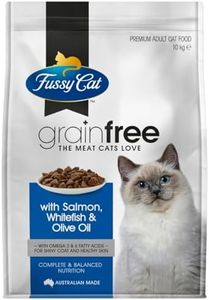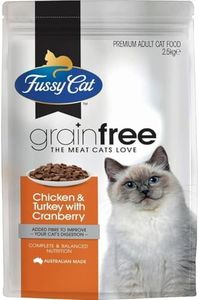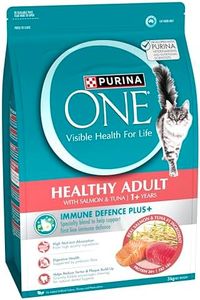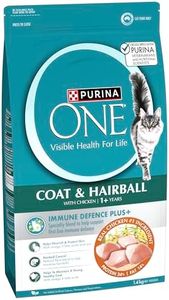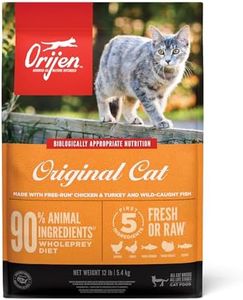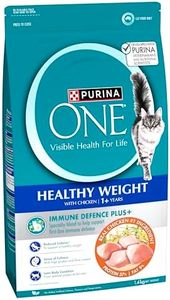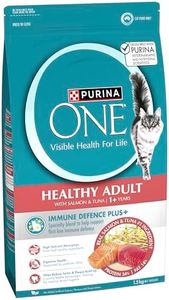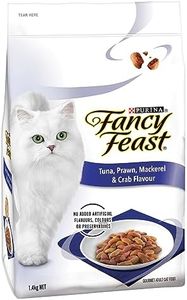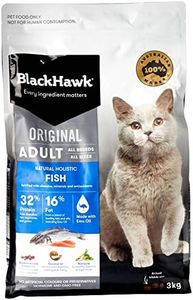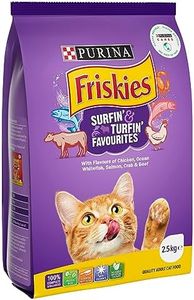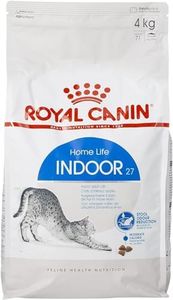We Use CookiesWe use cookies to enhance the security, performance,
functionality and for analytical and promotional activities. By continuing to browse this site you
are agreeing to our privacy policy
10 Best Dry Cat Foods
From leading brands and best sellers available on the web.By clicking on a link to a third party's website, log data is shared with that third party.
Buying Guide for the Best Dry Cat Foods
Choosing the right dry cat food is essential for your cat’s health, energy, and happiness. Every cat is unique, with different needs based on age, size, activity level, and sensitivities. When selecting a dry food, look for well-balanced formulas that suit your cat’s stage of life and any particular health considerations. Reading the ingredient list and understanding key nutritional information will help you make a choice that keeps your feline friend healthy and satisfied.Protein ContentProtein is a vital nutrient for cats because they are obligate carnivores, meaning their bodies are designed to thrive on animal-based protein sources. Protein content is usually listed as a percentage on packaging. Lower ranges (around 26-30%) may be suitable for less active or older cats, medium ranges (30-35%) cover most adult cats, and higher values (35% or more) are often sought for active, young, or breeding cats. Match the protein level to your cat’s energy needs; highly active or younger cats usually benefit from more protein, while seniors may do well on a moderate amount.
Fat ContentFat provides energy and helps keep your cat’s coat shiny and skin healthy. Fat content varies, typically ranging from about 8% to 20%. Lower fat is better for overweight or less active cats, while higher fat suits kittens, very active, or pregnant cats. To pick the right fat level, watch your cat’s weight and energy—if your cat needs to lose weight, go for a lower fat option, but for kittens or cats that burn a lot of calories, a bit more fat helps.
Carbohydrate LevelCats do not require carbohydrates as a major part of their diet, but dry foods often include them for structure and binding. Lower carbohydrate content (under 30%) is generally considered healthier, because high-carbohydrate diets can sometimes contribute to obesity and other health issues. If you have a cat with diabetes or weight concerns, opt for recipes with less filler such as corn, wheat, and other grains, focusing instead on foods richer in protein and fat.
Ingredient QualityThe source and quality of ingredients are crucial for your cat’s health. Look for foods with whole meat, poultry, or fish listed as one of the first ingredients, as this ensures a good protein source. Beware of foods that rely heavily on by-products or generic meat meals, as these are often lower-quality. If your cat has allergies or sensitivities, read labels carefully to avoid unwanted ingredients, and opt for simple formulas with recognizable ingredients.
Life Stage SuitabilityCats at different ages need different nutrition. Foods are typically labelled for kittens, adults, seniors, or all life stages. Kitten formulas are higher in calories and nutrients to support growth, while senior formulas are often easier to digest and contain nutrients to support aging bodies. Choose a food labeled for your cat’s current life stage to provide the right nutritional balance.
Special Dietary NeedsSome cats require food that addresses specific health conditions such as allergies, urinary issues, or sensitive stomachs. Special formulas cater to these needs by including or excluding certain ingredients. For example, grain-free or novel protein diets may help with allergies, while specific blends can help prevent urinary tract problems. If your cat has been diagnosed with any health issue, consult your vet and pick a food that addresses those needs.
Kibble Size and TextureThe size and texture of the kibble can impact your cat’s ability to eat comfortably, especially for kittens or older cats with dental issues. Small or softer kibble is easier for tiny mouths or cats with missing teeth, while regular kibble works for most healthy adult cats. Observe your cat’s eating behavior—if they struggle to crunch their food or lose interest, choosing a different kibble size or texture might help.
